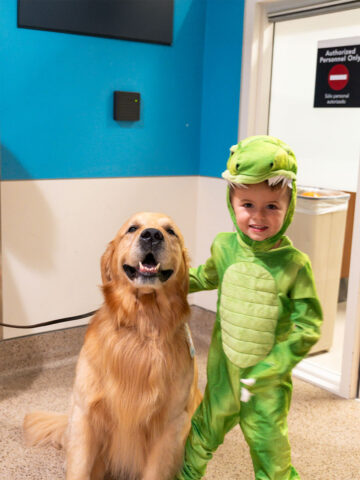By Nazli Boroshan, CHOC mental health therapist
One in five people under the age of 20 identify as lesbian, gay, bisexual, transgender or another LGBTQ+ identity.
As a parent or caregiver, it can be very hard to know how to respond to your child coming out, and it can be scary for children to share their identity with you for the first time. To better prepare yourself, you can refer to CHOC’s article, “Protecting the mental health of LGBTQIA+ youth,” to understand what different identities are and what they mean.
Everyone’s coming out experience is unique, and the way you respond can make a big difference to a child’s self-esteem and mental health. At first, when your child comes out, you might have some strong emotions such as fear, sadness or loss.
Your emotions are valid, so it is important that you take time to process your feelings and thoughts. Sometimes feelings such as fear can present as anger, disapproval or indifference. Try not to let your feelings take control of the relationship with your child.
Prepare
As a parent or caregiver, you are the expert on your child. If you notice your child is acting differently or might have something on their mind, ask them.
By checking in on your child, you are letting them know that you notice them and that they can trust you with anything. Remind them that you love them and are here to provide support, and to lend an ear or a shoulder to cry on.
Also, be prepared that your child might not be ready to talk to you at that very moment. Give your child time and space while staying prepared to talk when you are both ready. Expect to hear things you might not necessarily agree with or like and be prepared to handle it with confidence.
Stay calm
Calm, compassionate and clear communication is important to any mutually healthy, loving and respectful relationship. Often, children can feel scared of how their parent or caregiver will react when coming out, which can stop children from sharing what is on their mind.
By staying calm, you show your child that they are in a safe place, which encourages them to share their challenges. When a child is ready to share their identity with you, they may be looking for safety, comfort and guidance. It is important to let your child take the lead and give them a space to better understand themselves and their identity.
Allow them the time and space they need to share what is on their mind. Wait until your child is ready for you to ask questions or share your own thoughts. When appropriate, you can even ask your child if you can ask some questions, or if they are open to hearing your thoughts.
Try not to interrupt to finish their thoughts or sentences or say things in the heat of the moment that you might regret later. Also, coming out can sometimes happen during a heated argument, fight or moments of frustration and anger. Remind yourself that as a caregiver, your number one goal is to create a safe and comfortable space for them to explore and express themselves.
Be nice
Remember when you were a kid? Try to put yourself in your child’s position. How would you have liked your parents or caregivers to have responded to you if you came out to them, or shared something private?
You probably wouldn’t want to hear things like “I already knew,” “It’s obvious,” or “I could have told you this.” Other things to avoid saying include “You’re too young to know this,” “This is just a phase,” or “What a waste/shame.”
Avoid sharing the belief that being LGBTQ+ is a choice or blaming things like social media, education systems or friends for your child’s coming out. If your child feels safe and comfortable enough to open up to you for support, validation, or acknowledgement, it is a compliment to you as a caregiver.
Not all children feel safe or comfortable enough to share such personal information with a caregiver. Regardless of how you might feel in that moment, keep in mind that those feelings might change, which is why it’s so crucial not to react negatively.
Your initial reaction could be detrimental to your child’s perception of themself, or the way others might view them, and this perception can stick with them for a long time, or possibly permanently.
Take a moment and consider your body language
Your body language can say a lot about how you are feeling at any given moment. Consider the way you carry yourself during this time and think about how you can create a safe and comfortable space for you and your child.
Are you sitting down? Are you aimlessly pacing around the kitchen? Are you fidgeting around with your hands or tapping your feet? Are you paying attention to what your child is sharing? Are your arms crossed? Are you breathing heavily? Are you making eye contact with your child? Are you holding their hands or hugging them? Are you giving them the space they need? Is your voice gentle and soothing?
Nonverbal communication (body language) can convey to your child how you feel about what they are sharing with you. It can also help your child determine whether to feel safe enough to share their thoughts with you. It is important for you, as the adult in the relationship, to portray a higher level of communication by being mindful of your presentation, while observing the behaviors of your child to help guide them along the process.
During these conversations, at first, try to show you are listening without talking out loud or asking questions. Certain expressions such as fear, anger, surprise, and disgust can set the tone for not only the rest of the conversation but possibly the future of your relationship with your child.
Try to be gentle with the emotions you show. Consider your child’s personality, as well as any mental health or neurodevelopmental diagnoses they might have. Every child is unique, and by taking this into consideration, you can better meet your child’s needs. Also, think about how your culture/religion views what your child is experiencing, as well as how it could affect your response.
Respond, don’t react
When your child has shared what they need to, and you feel is appropriate for you to share what’s on your mind, you can start with phrases such as, “Thank you for sharing this me,” “I’m so glad you told me,” or, “Thank you for trusting in me to share something so important and personal.”
Ask your child how they are feeling about what they just shared with you, and how they would like you to support them. Maybe they just want a big hug and to hear that everything is going to be OK. Maybe they want you to find them some resources within the community so they can understand their experience better.
Ask your child if they have shared this information with anyone else, and don’t be surprised or get upset if you learn you are not the first. Often, children are more inclined at first to come out to close friends or other trusted adults, as they might feel more relatable or accepting of their needs. Believe it or not, children don’t always want to talk about sexual orientation or identity with their caregivers.
If your child has trusted you with their personal information and has asked you to keep this information private by not sharing it with others, try to honor and respect their desire. At times, children are hesitant to share personal information with caregivers out of fear of it being shared with another caregiver, or possibly other individuals (relatives, friends, neighbors, teachers, etc.). Trust is a key aspect of communication and is extremely important as it sets the foundation for a positive and healthy caregiver-child relationship.

Mental Health Education Program (MHEP) webinars
Ask for support
This is not an easy process for everyone, and every family is different. You may feel like you need some extra help to respond to your child coming out. A good place to start is by talking to your child’s primary care physician or finding a qualified therapist who can help guide you and your child in this challenging and important stage of life.
Get more expert health advice delivered to your inbox monthly by subscribing to the KidsHealth newsletter here.
Get mental health resources from CHOC pediatric experts
The mental health team at CHOC curated the following resources on mental health topics common to kids and teens, such as depression, anxiety, suicide prevention and more.





